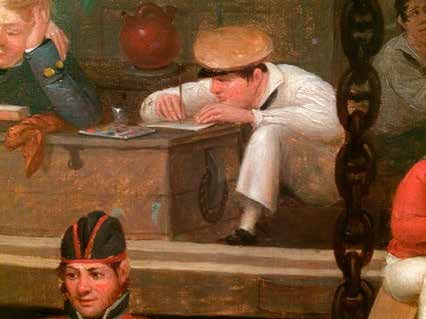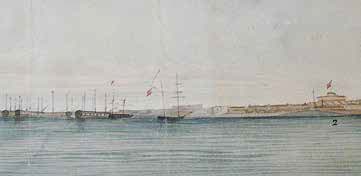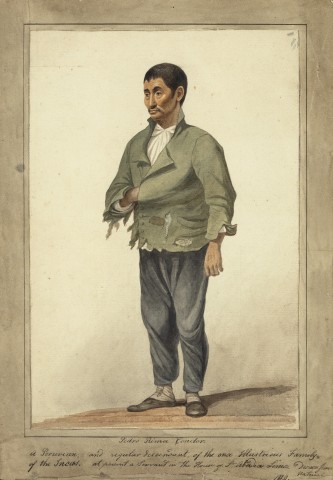PEDRO RIMA CONDOR. A PERUVIAN, AND REGULAR DESCENDANT, OF THE ONCE ILLUSTRIOUS FAMILY OF THE INCAS, 1820
AUGUSTUS EARLE
pencil and watercolour on paper on the artist’s washed paper mount
31.0 x 21.0 cm (sheet)
37.5 x 26.0 cm (mount)
inscribed with title and date on artist’s paper mount: Pedro Rima Condor. / a Peruvian, and regular descendant, of the once Illustrious Family / of the Incas. at present a Servant in the House of Sr Abadia Lima. Drawn from / nature. / 1820.
Possibly: The artist’s family (It seems probable that Pedro Rima Condor was once owned by a member of Earle's family. The portrait is mounted in the same way and carries the same kind of inscription (without the numbering), of the many drawings from an album once owned by Earle's half-brother, the Royal Navy hydrographer William Henry Smyth (the drawings are now part of the Nan Kivell collection, National Library of Australia)
Private collection, Northumberland, United Kingdom
Bearnes Hampton & Littlewood, Exeter, United Kingdom, 16 April 2021, lot 1562 (as ‘British School Early 19th Century - Portrait of Pedro Rima Condor, Full-length Standing’)
Private collection
This work will be included in the forthcoming monograph by Dr Mary Eagle on Augustus Earle.
A poignant image from embattled Viceregal Peru on the eve of the declaration of independence, this is a hitherto unknown watercolour from Augustus Earle’s visit to Lima, Peru between mid-July and early November 1820. Although modest and disarming in format (as if Earle is disguising his subversive message, sotto voce, in the familiar clothing of the costumbrismo tradition), the artist’s portrait of Pedro Rima Condor nevertheless broadcasts an indictment of Spanish colonial rule and its ruthless exploitation of the indigenous population – a message reiterated in Earle’s inscription. Earle’s subject here anticipates the subject matter that would interest and occupy the artist throughout his ever-itinerant career, as the indigenous, the colonised, and the enslaved, became centre stage in so much of his subsequent work in South America, Australia, New Zealand, and Asia. The portrait of the indigenous Pedro Rima Condor was painted in 1820 within a year of the proclamation of Peru’s independence on 28 July 1821, albeit decades before the feudal society of the Spanish Viceroyalty it so eloquently critiques was finally replaced by a democratic Republic. Earle’s portrait is as spare and mournful a marker of colonial Peru in 1820, as Rugendas’ suite of Peruvian paintings of the 1840s are extravagant and celebratory markers of the newly emerging Peruvian nation. We are grateful to Dr Mary Eagle for kindly granting permission to reproduce excerpts from her research on the present work, to be included in her forthcoming monograph on Augustus Earle.
1 AE.jpg

‘…The manner of this drawing in pencil, ink and watercolour, the uncanonical pictorial concept, and the English inscription and style of handwriting1 strongly substantiate the world-travelling Anglo-American painter Augustus Earle (1793 – 1838) as its creator. The attribution firms when we take into consideration that the work was painted in the embattled Spanish stronghold of Lima, in 1820. War was then imminent and Earle is the only non-Peruvian artist known to have been in Lima in 1820. Peru was embattled because Chile, the country bordering it on the south, upon throwing off Spanish rule in 1817 had turned immediately to the task of forcibly removing Spain from the region. Chile’s navy was under the control of Lord Cochrane, a profit-minded, ex-naval officer from England, who instituted a policy of raiding ports along the coast of Peru and confiscating ships and merchandise. In 1819, Cochrane temporarily blockaded Lima’s port of Callao, interrupting shipping in and out of the port. In August 1820, his squadron transported Chilean troops to a place from which they could attack Lima, then sailed on to blockade Callao, again freezing the movement of vessels into and out of the port. Peru declared its independence in July 1821.
Disembarking from a small American trading vessel in mid-July 1820, Earle moved freely between the port and the city six miles away, until early November when the Spanish administration ordered the immediate exodus of non-resident foreigners, and Earle, together with others of his nationality, was collected from the coast outside Lima by a British warship. For a month, he watched events from aboard HMS Hyperion before sailing on that vessel on 12 December, bound for England. The portrait of Pedro Rima Condor was painted sometime during the four and a half months between mid-July and early November. Painstakingly drawn from life, it pictures a subdued man, dressed in ragged clothes, his gaze averted from the artist. The portrayal was out of keeping both with Peruvian art and with the prevailing international mode of portraying national and occupational types. Portraits drawn from life were then very rare in Peru where a strong tradition existed of formal portraits in which the subject's social position was expressed through elaborate detailing and a lavish display of jewellery and gold leaf. (Besides Spanish Peruvians, the tradition included portraits of Inca ‘grandees.’) Capturing a facial likeness and a lifelike presence was of less importance in those beautiful images than portraying the subject’s place in society. After Peru’s independence, an existing international tradition flourished, of costumbrismo prints and drawings that portrayed a range of local occupations. These, too, were not portraits drawn from life but standardised depictions of the costume, activities, and mannerisms of a range of Peruvian types.2
The inscription below the portrait informs us that Pedro Rima Condor was a descendant of ‘the once Illustrious Family of the Incas.’3 The ‘Rima’ and ‘Condor’ of his name are variations of words in the Inca language Quechua (this being the sole Inca language the Spanish conquerors attempted to use and record). ‘Cuntur’ was the Quechua word for the great bird, the ‘condor’. Rima = Lima = Rimac referred to an Inca god (Rimachi – son of Tupac Inca) and to the region encompassing Lima and the Rimac river valley (this having been the most densely populated region in the Inca empire). As with many of Earle’s portraits, the face is shown in three-quarters view. The fully rounded head is sculpted to show the flat ridge of the forehead, the slope of the temple – its angle is echoed below by the line between nose and jaw – the long straight jut of nose, the small dark eyes rimmed by flesh, the distinctively shaped cheeks under high cheekbones, jutting lips, small chin and a slightly sunken jaw that curves below the cheek before turning in a straight line to the ear. As in other carefully studied portrait drawings, Earle outlined the fine wrinkles on the neck and cheeks, the broader frown lines on the forehead, and the parallel lines of facial hair. As well as following the bodily form, these lines delicately trace the lines of age and indicate a sustained unhappiness. Earle may have had Pedro in mind when, eleven years later, he characterised the Incas as ‘gentle and civilised.’4 The inscription goes on to say that Pedro Rima Condor was a servant in the home of ‘Sr Abadia.’ The servant’s shuttered face above patched and torn clothes could indicate an apathetic disregard for personal appearance, yet Pedro cared about personal hygiene – his shirt is clean – therefore the ragged outer garments were not due to carelessness but to sheer poverty. What does this say about his employer?
1 AE 2.jpg

Don Pedro Abadia was a prominent and influential Spanish merchant of Lima. Unlike the majority of Peru's Spanish merchants and administrators – who were monopolist and set in their ways – Abadia publicly endorsed free trade and modern machinery (for example, he imported English steam engines and employed Cornish miners to manage his mines in upcountry Peru), hence he was nudged into playing a major role in the trade war that accompanied the decline of Spain's power internationally in the early 1800s. Speculative traders from around the world, hoping to open rich new markets, flocked to Callao and on arrival sought the support of Abadia. Earle's first visit to the house would have been with the American trader, Captain Zacharias Nixon. In 1821 and 1822 Sir Walter Scott's garrulous friend, Captain Basil Hall, who patrolled the west coast of South America, on naval duty to protect British trading vessels, made a brief contact with Abadia, describing him as a generous public figure. Richard Cleveland, an American trader who had business dealings with Abadia and his partner, explained Abadia’s power: ‘His talents and education, and the extraneous circumstances of his being agent at Lima of the Philippine Company, and of his brother's being about that time one of the cabinet of King Ferdinand all combined to give him an influence with the Viceroy and the Cabildo, unsurpassed by any other individual in the kingdom.’ Cleveland was less complimentary about Abadia as a person: ‘... although of superior education, and extensive intercourse with mankind, he was bigoted and priest-ridden.’5 To which Earle’s portrait adds a further note – Abadia's generosity did not extend to his servants.
Earle's independent eye has earned him much attention – even more now that the imagery from Europe's colonies has come under serious review. Unlike the majority of artists who travelled abroad, Earle had few commercial outlets for his work. Apart from coastal profiles, panoramas and portrait commissions, he had two engagements as an illustrator. Most of his depictions of social life (totalling around 200) went into the possession of his family, and those works, rather than connecting with the practices of traditional travel art and the new modes of natural science, were Earle's private comment on what he saw in the many places he visited. Accordingly, it seems probable that Pedro Rima Condor was once owned by a member of Earle's family. The portrait is mounted in the same way and carries the same kind of inscription (without the numbering), of the many drawings from an album once owned by Earle's half-brother, the Royal Navy hydrographer William Henry Smyth (the drawings are now part of the Nan Kivell collection, National Library of Australia). Of Earle’s four known Peruvian subjects (four, now this work has surfaced), Smyth’s album included two, both of them coastal profiles. One is a drawing of the fort of Callao, evidently sketched from the deck of the Warrior between the American ship's arrival and Earle's disembarkation (National Library of Australia). The other is an immensely long 360-degree panorama sketched from aboard HMS Hyperion during the month that vessel hovered out of reach of Callao's guns (also National Library of Australia), while the third (untraced) Peruvian work, Road from Callao to Lima, is known through a copy drawing in the British Museum.
1. Earle's handwriting changed slightly over the years. This inscription fits the date of the work.
2. See exhibition catalogue: Maljuf, N., Reproducing Nations: Types and Costumes in Asia and Latin America, ca. 1800 – 1860, Americas Society, New York, 2006.
3. According to Stevenson in A Historical & Descriptive Narrative of Twenty Years’ Residence in South America (1825), p.303, ‘The principal occupations of the Indians who reside in Lima is the making of fringes, gold and silver lace, epaulettes, and embroidery; some are tailors, other attend the business of the market, but very few are servants or mechanics.’
4. Augustus Earle, A Narrative of a Nine Months' Residence in New Zealand in 1827; together with a Journal of a Residence in Tristan d'Acunha, London, 1832, p. 9
5. Cleveland, R.J., Narrative of Voyages and Commercial Enterprises, 3rd edition, Charles H. Peirce, Boston, 1850, pp. 392 – 3
